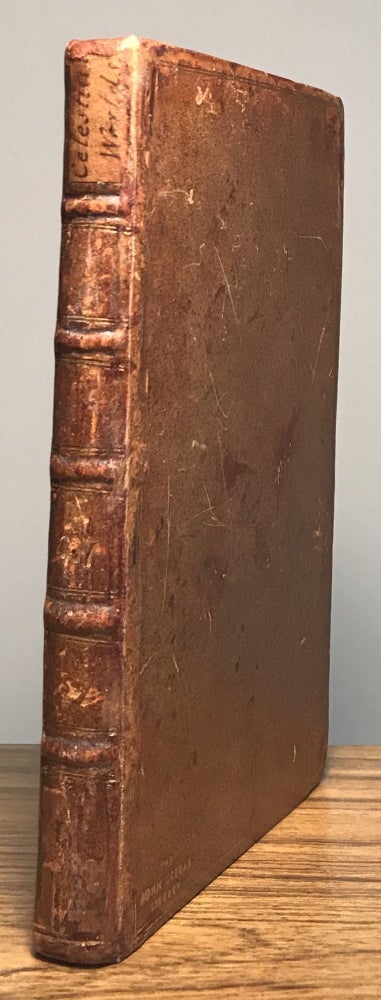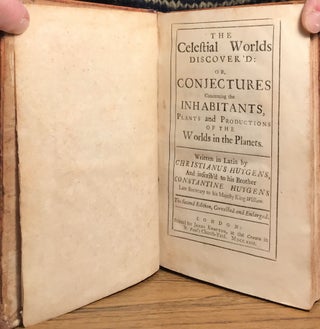THE CELESTIAL WORLDS DISCOVER'D: OR, CONJECTURES CONCERNING THE INHABITANTS, PLANTS AND PRODUCTIONS OF THE WORLDS IN THE PLANETS. Written in Latin by Christianus Huygens, and Inscib'd to his Brother Constantine Huygens Late Secretary to his Majesty King William. The Second Edition, Corrected and Enlarged. London: Printed for James Knapton, at the Crown in St. Paul's Church-Yard, 1722. Small octavo, pp. [i-ii] iii-vi 1-162, five engraved folded plates, contemporary sprinkled calf, all panels ruled in gold, title in a contemporary hand on the spine panel, all edges sprinkled red. Second edition in English, corrected and enlarged. A major early work on the notion of the plurality of worlds and speculations about life on other planets by the Dutch scientist and mathematician Christiaan Huygens (1629-1695), a major figure in the scientific revolution. It was first published posthumously in The Hague in 1698 as KOSMOTHEÔROS, SIVE DE TERRIS COELSTIBUS, EARUMQUE ORNATU, CONJECTURAE. The work was translated from the Latin by John Clarke, Dean of Salisbury. Initially published in Latin, the work was "rapidly translated into French, the language in which the author had initially intended to write it, as well as English and several other languages ... The decision to publish in Latin was probably precautionary, although the author did make every attempt to issue the book while he was alive, and the fact that it only appeared posthumously was, in this case, an accident. Huygens' book begins with a defense of the Copernican theory, but effectively considers the case already proven, and moves swiftly on to the argument that the other planets in the solar system are highly likely to be inhabited, what the likely forms of animals there might be, and whether those animals might be rational beings different in form from humans, but doubts that their rationality could be different, even if they were equipped with different senses. He argues that rational beings on other worlds are likely to be similar to humans, not because of any divine plan -- although he does argue that the variety of life on all worlds of existence is a reflection of the glory of God's creativity -- but because of the kinds of physical adaptation that allow reason to develop and flourish. In the second part of the text, Huygens goes on to consider the planets one by one, trying to estimate by means of astronomical observations and logic what conditions might pertain on their surfaces. He does not get very far with that, and is very tentative in the conclusions he draws, but the result is less significant than the method and style of argument that he employs, and the manner in which he attempts logical deductions in the same vein as Kepler's. The book was widely read, and although its influence was slow to take full effect, it is noticeable that it reflects the beginning of a change of attitude. It remained the case almost throughout the eighteenth century that expeditions to the Moon and other planets were undertaken in a satirical spirit, in order to parody earthly behavior, and the names of the planets were simply employed to signify displacements of society. Nevertheless, prompted by Fontenelle and aided by Huygens, some writers began to move toward a different way of thinking, not simply about the possible variety of life outside the Earth, but also the way in which to rationalize and make sense of that variety -- thus moving the argument regarding the plurality of worlds gradually, into a new phase that was ultimately to become one of the key characteristics of 'roman scientifique.'" - Stableford, The Plurality of Imaginary Worlds: The Evolution of French Roman Scientifique, pp. 69-70. The plates include an illustration of Saturn, with the ring that was first described by Huygens in 1656. ESTC R5990. DSB VI, pp. 597-613. Bookplates of the Earl of Pembroke and The John Crerar Library, Chicago, on the front paste-down, the John Crerar Library deaccession stamp on their bookplate. Crerar Library shelf number on spine and at bottom of page iii. Binding slightly rubbed with some refurbishing and restorations to the spine panel. A very nice copy with remarkably clean plates and text block. Enclosed in a custom quarter green leather velvet lined clamshell box. (#160966).
Price: $4,500.00
"The Second Edition, Corrected and Enlarged" on the title page.



